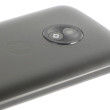Review: Samsung Galaxy J7 for Boost Mobile
Jul 8, 2016, 3:10 PM by Eric M. Zeman

Samsung's mid-range Galaxy J7 finds solid footing among Boost Mobile's smartphone roster. This Android handset brings a lot to the table with a 5.5-inch screen, 13-megapixel camera, and Android 6 Marshmallow. Here is Phonescoop's full review.
Hardware
Is It Your Type?
The Galaxy J7 for Boost Mobile is a classic mid-range handset from Samsung. The J7's looks resemble those of Samsung's high-end phones, but the J7 is far more affordable. If you're in the market for a solid performer that's a cut above the rest — and won't break the bank — the Galaxy J7 should be on your list.
Body
The Galaxy J7 is larger, more powerful, and more attractive than the Galaxy J3, which is also sold by Boost Mobile. The J7 relies heavily on Samsung's tried-and-true industrial design, which means a thin slab with rounded corners and plenty of chrome accents. It's not made of metal and glass, but it looks like it is. Some might even mistake the J7 for a Galaxy S.
Our review unit has white coloring around the screen and a white rear panel. The two are attached to a shiny chrome-colored frame. The frame is polycarbonate, despite its resemblance to aluminum. The rear panel has a matte texture, but there is something in the paint that adds depth to the panel's appearance. Samsung could easily have slapped a glossy rear shell on the J7, but gave it a wee bit of personality instead.
The phone's size lands in phablet territory thanks to the large 5.5-inch display adorning the J7's face. It's slender, but big enough that those with small hands may find it too big. I didn't have any trouble using it. The weight is very nice, so I never encountered hand fatigue even after holding it for about an hour straight. It fits in pockets, but like any phablet your mileage will vary based on the pants or shorts you prefer.
If you've ever played with or used a Galaxy S6 or S7, the J7 won't feel as nice. The J7 is made of plastics. At the same time, it feels much better to use than the cheap plastics that make up the J3. In other words, it's what we expect from a mid-range handset. The rear shell has a pleasing, if subtle, texture that I rather like, while the frame is super smooth. The J7 isn't going to bowl anyone over, but it isn't going to disappoint, either.
A rim surrounds the screen and will help protect it when placed face down. Rims can often be sharp or otherwise irritating, but that's not the case here. Samsung kept the bezels to a minimum. The user-facing camera has its own LED flash. Below the display are Samsung's typical buttons. The home button is a flattened circle with a chrome rim. I'd call the profile and travel/feedback close to perfect. It's a bummer there's no fingerprint reader. Two capacitive keys flank the home button: app switcher on the left and back on the right. These buttons work well.

Samsung could have done a little better with the volume toggle, which is positioned at the top of the left edge. It's too easy to press the button near the middle, which can turn the volume up-then-down or down-then-up. A weird double-click takes place that immediately counteracts whichever action was first. I've never encountered such an odd button. The screen lock button, on the right side, is too small for my tastes, but it works well enough. The headphone jack and the micro USB port are tucked into the bottom edge.
The camera module is perched on the back with an LED flash to the left and two thin openings for the speakerphone to the right. The camera sticks out noticeably from the rear and has a reflective chrome rim. A notch on one side of the back panel helps in its removal. The panel feels pretty danged flimsy when not hugging the phone's rear. As with many Samsung phones, the battery is removable, and in fact must be pulled in order to access the SIM card. The memory card slot is stacked on top of the SIM card slot, but can be accessed with the battery in place.

Samsung did a commendable job in designing and building this mid-ranger. The hardware isn't perfect, but it will be good enough for most people.
Screen
A 5.5-inch, 720p HD display covers most of the Galaxy J7's pretty face. A screen this big would benefit from more pixels. The pixel density comes in at about 267ppi, which is fairly low these days. I was able to see individual pixels from time to time, a rarity on what's technically a high-definition display. What the J7's screen lacks in resolution, it makes up for in sheer luminosity. The AMOLED surface is brilliantly bright. You can use this phone outside on a sunny day with absolutely no problem. Viewing angles are excellent; the display shows no blue shift, nor drop in brightness.
Signal
The Galaxy J7 connects to Sprint's LTE network just fine. (Boost is a Sprint brand.) The phone remained connected to 4G the entire time I tested the phone; it did not drop down to 3G at all. More simply put, the J7 performs a little above average when compared to other phones on Sprint's network. The phone connected calls on the first dial each and every time, it never dropped any calls, and it never sent calls straight to voicemail. Data speeds were quite good. The phone was quick to stream YouTube videos and Spotify playlists over LTE. Browsing speeds are excellent and even app downloads were painless. Poor signal strength had almost no impact on the J7's network performance.
Sound
Do you make a lot of calls? The Galaxy J7 has your back. I was pleased with call quality through the earpiece, which delivers good volume and clarity. The J7 produces enough volume so calls can be heard in coffee shops, diners, malls, the car, and other not-so-quiet places. Voices come through free of distortion and have a pleasant tone to them. You should be able to make calls with the J7 in most environments with abandon. People I spoke to through the J7 said I sounded "very good."
Call quality via the speakerphone is decent, but I've heard better. Volume is just shy of where I want it to be for calls in the car or anywhere else outside of my home or office. Clarity suffers from a small amount of distortion, but it's not a deal-breaker by any stretch.
Ringtones and other bleeps and bloops nearly always got my attention. The vibrate alert is good and strong.
Battery
The J7 has a respectable 3,000 mAh battery, which is larger than that of the J3 and equal to that of Samsung's flagship, the Galaxy S7. Over the course of a week of testing, the J7 consistently pushed from breakfast to bedtime with power to spare. As noted above, the phone was always on LTE 4G and I kept the GPS, Bluetooth, and WiFi radios on at all times. I streamed Spotify to a Bluetooth speaker for two hours and the battery barely budged 3%. The J7 required more than 30 hours of heavy use to kill the battery completely, which means most people should be pleased with its performance. We can probably thank the 720p screen (with its fewer pixels to manage) for the solid battery life.
If that's not enough battery life for you, feel free to take advantage of the Power Saver and Ultra Power Saver modes baked in by Samsung. The former reigns in the processor a bit, dims the screen, and tames notifications. The latter locks down everything but the phone and messaging apps. Basically, Ultra Power Saver dials the J7 back to what phones were like in 2002.
Bluetooth, GPS, NFC, WiFi
If I can stream Spotify via WiFi to a Bluetooth speaker that NFC helped me pair with, you can assume the secondary radios all work well.
Truly, the Bluetooth radio deserves top marks. Pairing was easy with all manner of devices and call quality via dedicated headsets and my car's hands-free system were very, very good. Music sounded excellent through a Bluetooth speaker.
I put the NFC radio to use in helping pair some of these devices, so I know it works. The NFC function can work with Android Pay, but not Samsung Pay (which Samsung is still reserving for its flagship phones.)
The GPS radio performed quickly and accurately, which is all I ask from modern phones. The radio pinpointed me in just a few seconds and to within about 15 feet. The Galaxy J7 functioned very well as a navigation tool, even in the northwest sticks of NJ where cell phone signals often go to die.
The WiFi was reliable and speedy.
Software
Lock Screen
The J7's lock screen covers the basics in terms of keeping you up to date. Samsung hasn't made any substantive changes to its lock screen treatment in some time. A large clock is positioned at the top of the screen. Notifications line up dutifully below the clock and a pair of app shortcuts (phone and camera) fill out the bottom corners. I wish the lock screen included the current weather and let you add more than two app shortcuts.
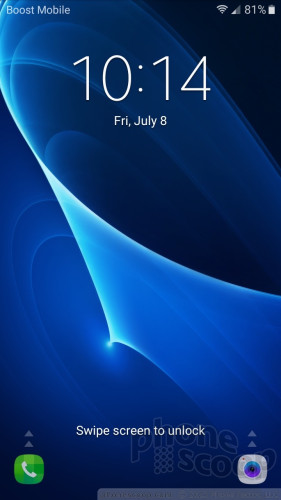
Controlling how notifications appear on the lock screen takes a bit of work, but the rewards are worth it. For example, you can turn off notifications on an app-by-app basis as well as manage how much information is shared above the security layer.
Speaking of security, the J7 is limited to PIN, pattern, and password. The phone doesn't have a fingerprint reader or any other fancy lock methods.
Home Screen
The Galaxy J7 runs Android 6 (Marshmallow) with Samsung's interface on top. If you've used a Galaxy handset any time over the last few years, you'll know exactly what to expect.
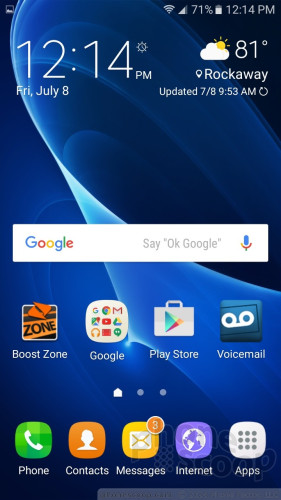
Three home screen panels are active when the phone first boots. All three are cluttered up with a mix of Samsung, Boost, and Google apps. Customizing these screens is easy enough, though removing all the carrier-positioned junk is a pain. The home panels support 4x4, 4x5, or 5x5 grids, which is nice. You can add as many home screens as you want. My biggest complaint about the home screen panels is the location of the app drawer. The app drawer is locked to the far right side of the dock at the bottom of the screen. I prefer it to be in the middle. It's weird that Samsung doesn't let you change this.
The full app menu is arranged in side-by-side panels. Boost preloaded several folders on the first app panel, but the rest of the apps are tossed in rather haphazardly. Samsung allows users to list apps alphabetically and stuff them in folders. About half of the apps can be turned off, or effectively hidden (but not uninstalled).
The Quick Settings panel drops down to provide access to various toggles, screen brightness controls, and notifications. It's very easy to edit the position of the toggles to your liking.
The full settings options are arranged in a single screen. Some prefered settings options are lumped at the top. I like that Samsung allows you to choose which ones. The rest of the settings menu is laid out in a vertical list. The search tool might be the easiest way to find the setting you seek to adjust.
Samsung's Easy Mode is available if you really want to dumb the phone down. Easy Mode is best left to those who prefer a simpler experience.
Qualcomm's Snapdragon 415 processor, clocked at 1.4 GHz, powers the phone. It's nice to see 2 GB of RAM in the phone. The processor provides plenty of power for this phone. The J7 worked flawlessly while I reviewed it. The phone was quick to open apps and the home screen experience was always smooth. I'd liken the J7's processor to a peppy 4-cyl turbo engine. It's no V6 nor V8, but it's surprisingly quick and efficient.
Camera
A quick double-press of the home button launches the camera in a hurry. This is always the fastest way to access the camera, whether the phone is locked or not. You may also resort to the lock screen or homescreen shortcuts.

Samsung's camera app hasn't changed much the last few years, which means the J7's camera app looks and behaves similar to that of the S7 and myriad other Samsung phones.
Shutter controls and shooting modes are located on the right side of the viewfinder, while some standard controls (effect, timer, flash, resolution, settings) are on the left. A small arrow in the upper left corner allows you to hide or reveal these controls. The settings are rather limited. You can play with location tags, grid lines, and so on. The effects include grayscale, sepia, and negative.
There are two shutter buttons, one for pictures and one for video. The default shooting mode is auto. The more advanced shooting modes include pro, panorama, burst, beauty face, sound & shot, sports, and HDR.
The pro mode adds controls for white balance, exposure, ISO, and metering. These tools aren't available in the auto mode. I suggest you stick with the pro mode if you want to have even this modest amount of control over the camera's behavior. The rest of the shooting modes perform more or less as you'd expect them to. I do wish it were easier to access HDR. It would be better if HDR were available from the camera's main screen rather than buried in the shooting modes.
The J7 carries over some of the J3 and S7's fun selfie tools. For example, this is where you'll get the most use out of the Beauty Face tool, which adds a level of beautification to your selfies. It smoothes out skin imperfections, but I find you have to keep its strength settings at a minimum unless you want to look like like you're wearing 10 pounds of makeup. The J7 also lets you take a burst of selfies, wide-angle selfies, and sound & shot selfies.
The camera app is quick and the interface is simple enough to master.
Photos
A 13-megapixel sensor lurks under the camera lens. It sometimes gets confused. In the plus column, the phone does a really good job with focus and white balance. The vast majority of shots I took were sharp, had accurate color, and were free of grain.
But exposure is somewhat of a problem. In places where lighting is even, the J7 does fine (see clock, balloon), but in spaces where there are bright and dark spots, the J7 loses its mind completely. You can see how overexposed and/or underexposed some of the samples are below. Look at the shot of my backyard for example, which is nearly pitch black in the shaded areas. Switching to HDR helped, but went too far the other way and left the rock wall overexposed. Many images reveal an overexposed sky in favor of a properly exposed subject. HDR helps to some degree, and in fact is almost mandatory when the lighting conditions are complex. It takes work and practice to tame this camera. It shouldn't.
The selfie camera doesn't do much better, as it uses the same image processing algorithm for exposure.
Often, video mode is able to provide a more even experience as far as exposure is concerned. Video results are, in fact, less over/under shot but still suffer from problems.
Bottom line: the J7 takes good shots only occasionally. I wouldn't trust it for vacations, let alone important events. It suffices for everyday shooting needs.
Boost / Samsung Stuff
Sigh... bloatware. Like the J3 sold by Boost, the J7 has a whole suite of Amazon apps (shopping, music, photos, video) and Galaxy apps (Milk Music, Galaxy App Store) from Samsung. Boost Mobile apps are numerous (Fun&Games, Zone, Gadget Guardian, airG, Dealz, TV, 411, Music). Other third-party apps pre-installed include Uber, NextRadio, and Instagram. Unwanted apps can be disabled, which puts them into a sort of hibernation mode but leaves them on the phone. The J7 has 16 GB of storage, only 10.3 GB of which you have access to. I strongly suggest you pick up a memory card.
Wrap-Up
Every phone has a weakness, but the Galaxy J7's greatest fault came as a surprise to me.
The phone — which Boost Mobile is selling for $229 — is attractive, well-made, and functional as a piece of hardware. Many will appreciate the large screen and removable battery/memory. More importantly, the J7 delivers excellent battery life, above average call and data performance, and very good Bluetooth/GPS. These are clutch strengths.
The Marshmallow operating system and Samsung's TouchWiz software are familiar and functional. Each offers plenty of room to customize the handset and optimize its performance.
The J7's camera, however, really let me down. It's certainly not the worst camera I've ever used, but it is inconsistent enough that I'd never want to rely on it for the bulk of my shooting needs.
Boost is charging a reasonable price for this phone, though it sells several others in the same range (LG Stylo 2, iPhone 5s). If camera performance is critical to you, skip the Galaxy J7 and opt for the iPhone 5s instead. If you don't care that much about photography and value battery life and call/data quality more, then the J7 makes more sense.

Comments
nothing but issues






















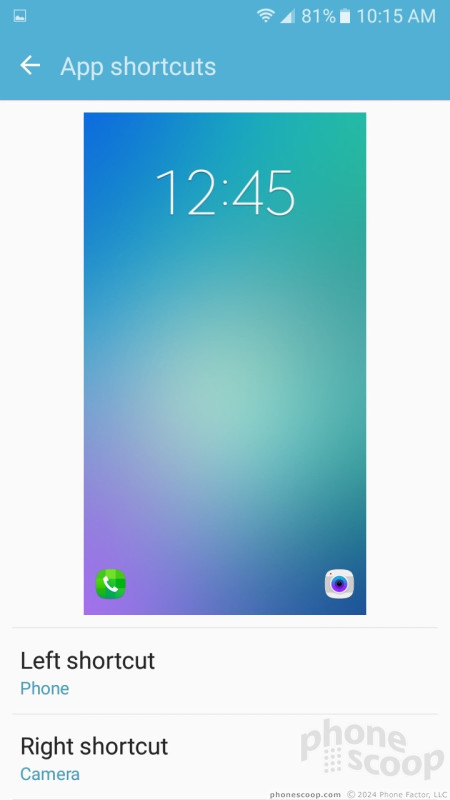










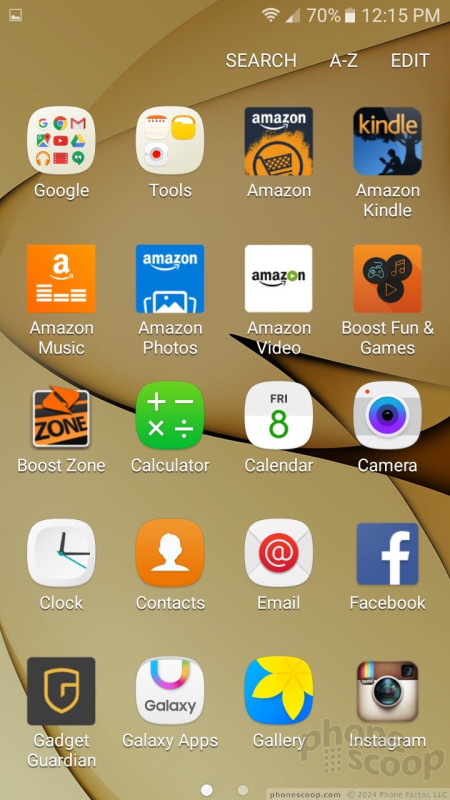









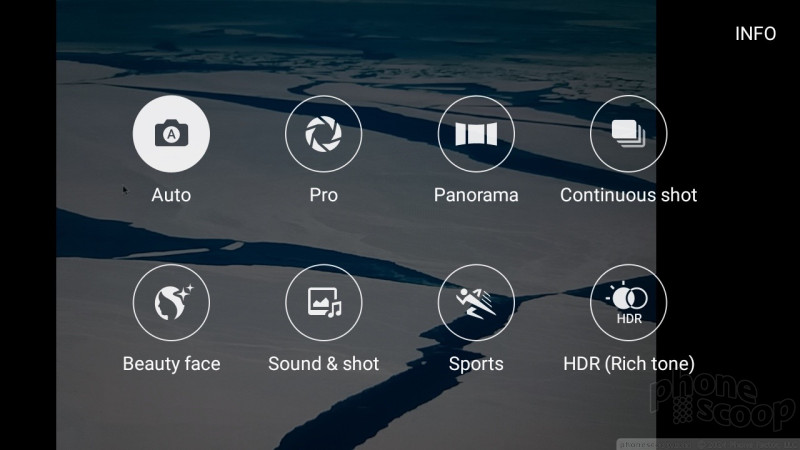






















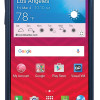 Boost and Virgin Mobile Score Kyocera Hydro Reach
Boost and Virgin Mobile Score Kyocera Hydro Reach
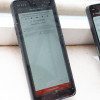 Qualcomm vs. Bullitt: Satellite Connectivity Comparison and Hands On
Qualcomm vs. Bullitt: Satellite Connectivity Comparison and Hands On
 iPhone 15 Series Goes All-In on USB-C and Dynamic Island
iPhone 15 Series Goes All-In on USB-C and Dynamic Island
 Samsung S24 Series Adds More AI, Updates the Hardware
Samsung S24 Series Adds More AI, Updates the Hardware
 Hands On with the Motorola razr and razr+ (2024)
Hands On with the Motorola razr and razr+ (2024)
 Samsung Galaxy J7 (2016, CDMA)
Samsung Galaxy J7 (2016, CDMA)



